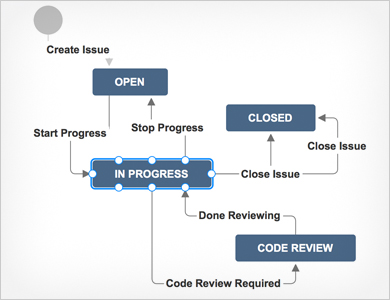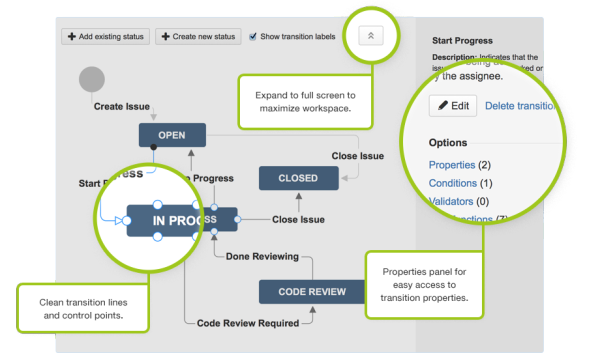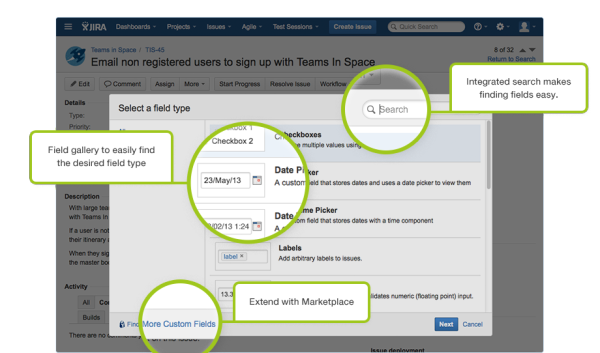I’m pleased to announce the availability of Jira 6.1. We’ve continued the work in creating a whole new Jira: modern, fast, mobile, and simple. This release focuses on several key areas of the administrator’s workflow, and makes it easier for developers getting started coding. We’ve made it simple to embrace change within your organization with building workflows, better managing fields, and getting started with development. We’ve also added a couple of key enhancements that you, our customers, are passionate about. Keep reading to see what’s in store!
Workflow: What makes working together work
 Jira’s leading workflow engine is one of the key advantages that teams have come to rely on for managing their work. Why is workflow so important? Flexible workflows allow your team to build the culture that uniquely works for you. For example, if your organization does code reviews, making it an explicit step keeps everyone on the same page about what work needs to be done to complete that issue. Leaving it as in progress results in confusion about what actually needs to be done. Effective workflows help the team see what work needs to get done and what the path to completion is for each individual issue. Optimized teams can then deliver more quickly, and with higher quality.
Jira’s leading workflow engine is one of the key advantages that teams have come to rely on for managing their work. Why is workflow so important? Flexible workflows allow your team to build the culture that uniquely works for you. For example, if your organization does code reviews, making it an explicit step keeps everyone on the same page about what work needs to be done to complete that issue. Leaving it as in progress results in confusion about what actually needs to be done. Effective workflows help the team see what work needs to get done and what the path to completion is for each individual issue. Optimized teams can then deliver more quickly, and with higher quality.
Jira 6.1 includes a modern HTML 5-based workflow editor that makes it easy to design workflows directly inside Jira. The new editor includes control points for ease in creating transitions. The high-quality workflow diagrams can easily be shared with the team so everyone stays on the same page. A visual workflow diagram helps the team understand the flow; either when rolling out a new change, or onboarding a new team member. Also, be sure to enable the view workflow option in issue detail view so everyone can see where their issues are in the overall workflow.
Fields: Details do matter
Software is constantly evolving. When developers add new features and solve new use cases, they often need to collect additional information from a range of teams in order to reproduce issues. I’m excited to announce that it’s now easier than ever to work with fields in Jira.
When viewing an issue, an administrator can simply add a new field right from the issue details page. Jira then guides the administrator through a wizard that will add the field right inline on the issue detail page. Custom fields allow you to track additional properties for each issue type. For example, let’s go back to the code review step above: Having a custom field called risk informs the code reviewer how sensitive the change was for the original issue. The reviewer now has better context, and is more empowered to use his or her time effectively.
Search Results: Make informed decisions
We’ve also made it easier to add and remove columns when viewing search results. As the team is preparing for release, they want to see what changes are in the candidate build. Adding the risk column to the search results makes it easy to see what changes might need extra testing. It’s also a key indicator of the overall risk of the deployment.
Having the right columns when reviewing search results makes better use of screen real estate, and gives the viewer the right context to make effective decisions.
Code: Get started quickly
 As developers, we want to spend our time delivering features. With Jira 6.1, we’ve made working with Git and Mercurial easier. If you track everything in Jira, start the development work from an issue right away by creating a feature branch. Jira helps you get started by pre-populating the branch name, project, repository, branch type, and source branch. Just integrate Jira 6.1 with Stash 2.8 or later (behind the firewall Git) or Bitbucket (hosted Git and Mercurial).
As developers, we want to spend our time delivering features. With Jira 6.1, we’ve made working with Git and Mercurial easier. If you track everything in Jira, start the development work from an issue right away by creating a feature branch. Jira helps you get started by pre-populating the branch name, project, repository, branch type, and source branch. Just integrate Jira 6.1 with Stash 2.8 or later (behind the firewall Git) or Bitbucket (hosted Git and Mercurial).
Does your team work across multiple source code repositories? Not a problem! For larger organizations, Jira links to multiple instances of Stash and Bitbucket in our new feature branch workflow.
But wait, there’s more!
Jira 6.1 has even more! You can check out the release notes for more details, but here are a few more gold nuggets from Jira 6.1
- Editable project keys – Have you ever had a project name change? With Jira 6.1 you can easily update the project key, and embrace the new project name. Thanks for your 300 votes on this one. Give it a spin in this release!
- New look for email notifications – We’ve brought the Atlassian Design Guidelines (ADG) to notifications. We’ve also made it easier to customize the email Jira sends by better separation between content and style.
- Faster access to Jira reports – Reports are now easily accessible from their own tab, under the browse product page.
- Changeable usernames in LDAP – With Jira 6.1, you can now change usernames in external LDAP directories
Ready to accelerate change with Jira 6.1?
Jira 6.1 helps your organization change when it needs to by being the most flexible Jira yet. Admins can more effectively customize workflow and add the attributes users need to individual issues. Users can work with search results faster, and enjoy cleaner notifications of issues they need to respond to. Give Jira 6.1 a try and see how nimble your organization can be!
Try Jira 6.1 today!
New to Jira?
Get up and running in a matter of minutes with a free 30-day Jira OnDemand trial.
Ready to upgrade?
Check out the full release notes and start seeing real results with Jira 6.1 today.
OnDemand Customers: Congrats! You’ve have been auto-upgraded to Jira 6.1!
Keep an eye on http://atlassianblog.wpengine.com/jira/ over the next few weeks. We will be going into depth on several new features in Jira 6.1.


